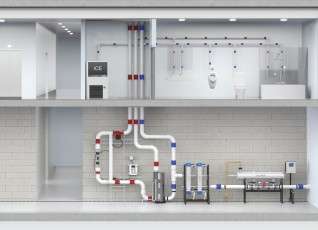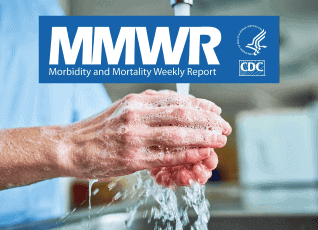Multi-Barrier Approach: Setting a New Standard for Water Safety

Healthcare facilities today face increasing water safety risks. Aging infrastructure, frequent water main breaks, and elevated sediment levels are straining plumbing systems and creating ideal conditions for waterborne pathogens to thrive. Municipal treatment processes, while essential, often don’t address these downstream challenges once water enters a facility. The result is a growing concern for occupant safety, equipment reliability, and compliance. One healthcare facility confronted these realities head-on after dealing with Legionella positivity in its cold-water system, as well as recurring detection of Pseudomonas, Acinetobacter, and Stenotrophomonas. Beyond microbial risks, high sediment loads from the municipal water supply were causing significant damage to plumbing infrastructure, increasing maintenance costs, and accelerating corrosion. Traditional remediation approaches were unable to deliver sustainable results. The Challenge The facility needed a comprehensive strategy that could both eliminate pathogens and reduce the environmental conditions that allowed them to flourish. The solution: A multi-barrier approach To address these challenges, LiquiTech implemented a multi-barrier water treatment solution designed to deliver layered protection: Together, these technologies worked in synergy to address the root causes of water quality problems and provide sustained protection. The results By addressing microbial challenges, sediment-related damage, and infrastructure reliability together, the facility established a new standard of care for water safety. The solution not only safeguarded patients and staff but also delivered measurable operational and financial benefits. Connect with an expert Fill out the form below to connect with a LiquiTech expert to explore how a multi-barrier water treatment approach can help protect your facility’s water, systems, and ROI.
Healthcare Solutions: How to Reduce Waterborne Pathogen Risk

In healthcare settings, it is crucial to take every precaution to ensure patient safety and well-being, including the quality of water used throughout the facility. Waterborne pathogens, commonly present in building water systems, can pose serious health risks, particularly to individuals with weakened immune systems. This blog post will delve into common waterborne pathogens, their effects, and the preventive measures necessary to maintain safe water in healthcare environments. Understanding common waterborne pathogens and their impact Waterborne pathogens are microorganisms that thrive in water systems and can cause severe infections. Healthcare facilities, with their complex and extensive water systems, provide an ideal environment for these pathogens to proliferate. The presence of immunocompromised patients and the use of medical devices that rely on water further increase the risk of infections. Awareness and proactive management, including regular water testing, system maintenance, and the implementation of effective disinfection protocols, are essential to prevent outbreaks and protect patients and staff. Legionella Legionella bacteria can thrive in complex water systems, such as those found in hospitals. These bacteria can cause Legionnaires’ disease, a severe form of pneumonia. Legionella is primarily transmitted by inhaling small water droplets containing the bacteria, which can occur through showers, cooling towers, and decorative fountains. Aspiration of contaminated drinking water can also lead to infection. Regular assessment and maintenance of water systems are crucial to preventing Legionella growth. This includes routine cleaning and disinfection of cooling towers and decorative fountains. Copper-silver ionization, a method that continuously disinfects potable water, has proven effective in controlling Legionella populations. Having a robust outbreak response plan is essential. This includes rapid identification of suspected Legionnaires’ disease cases, patient testing, and environmental sampling for Legionella. Quick action can help contain the spread and prevent further infections. Pseudomonas Pseudomonas, particularly Pseudomonas aeruginosa, thrive in moist environments. It can be found on medical equipment and in water sources, posing significant risks to patients, especially those with weakened immune systems. In healthcare settings, Pseudomonas can lead to various infections, including pneumonia. Effective water management, monitoring, rigorous cleaning, and disinfection protocols are vital to controlling Pseudomonas. Regularly disinfecting sinks, showers, and medical devices that come into contact with water can significantly reduce the risk of infection. Ensuring that all equipment is thoroughly sterilized is also crucial. Healthcare providers should be vigilant for symptoms of Pseudomonas infections, particularly in critically ill or post-surgery patients. Early detection and prompt treatment can prevent complications and improve patient outcomes. Stenotrophomonas Stenotrophomonas maltophilia (S. maltophilia) is a growing concern in hospitals due to its multidrug resistance. This organism often causes healthcare-associated infections (HAIs), affecting patients with compromised immune systems or those with indwelling devices like catheters and breathing tubes. S. maltophilia’s resistance to many common antibiotics makes infections challenging to treat. Understanding its resistance patterns is crucial for effective treatment. Physicians must stay informed about the latest guidelines and treatment options. To limit the spread of S. maltophilia, implement effective water management strategies, perform strict environmental monitoring, and implement disinfection procedures. Hand hygiene and device sterilization play a significant role in preventing transmission. Regular audits and staff training can help maintain high hygiene standards. Acinetobacter Acinetobacter baumannii is notorious for its resilience against antibiotics. This highly antibiotic-resistant pathogen often affects patients in intensive care units (ICUs) or those with compromised immune systems, leading to severe infections. Rigorous infection control measures are necessary to combat Acinetobacter. This includes water management practices, regular handwashing, sterilizing equipment, and implementing isolation protocols for affected patients. Preventing outbreaks requires a coordinated effort from all healthcare staff. Proactive surveillance for Acinetobacter is critical. Regular screening and monitoring can help detect infections early. Judicious antibiotic use, guided by susceptibility testing, is also key to managing its spread and improving patient outcomes. Solutions for healthcare facilities Waterborne pathogens pose a significant threat to healthcare facilities, but with proper awareness, preventive measures, and a coordinated effort from all healthcare staff, their impact can be minimized. By understanding the risks and implementing effective strategies, like water management programs, regular maintenance of water systems, rigorous infection control protocols, and proactive surveillance, we can ensure safer water systems and improve patient and staff safety. Our solutions, including copper-silver ionization, are effective against a broad spectrum of pathogens, including those discussed here. Implementation of these strategies can significantly reduce the risk of infection from water sources. Learn more about how healthcare facilities partner with LiquiTech or contact us today to explore our water treatment solutions designed to protect your patients and staff.
How Weather, Climate, and Water Sources Impact Waterborne Disease Hospitalizations

A recent study from Columbia University, published in the open-access journal PLOS Water, investigates how weather conditions, climate, and water sources affect hospital admissions for waterborne infectious diseases in the United States. The study examined 12 years of data from 516 hospitals in 25 states. Key findings on biofilm-forming bacteria Biofilm-forming pathogens, such as Legionella, Pseudomonas, and Nontuberculous mycobacteria (NTM), thrive in biofilms within water distribution systems and are responsible for respiratory infections, especially among vulnerable populations like individuals over 55 or those who are immunocompromised. During the study period, biofilm-forming bacteria were responsible for 81% of all waterborne disease hospitalizations. Geographical and environmental influences Conclusion The study identifies a clear link between meteorological conditions, drinking water sources, and hospitalization rates for waterborne diseases. With climate change potentially leading to more extreme weather events, the study highlights the need for improved water infrastructure and water management practices to mitigate the risk of these waterborne infections, particularly in urban areas and regions dependent on groundwater sources.
Cluster of Carbapenemase-Producing Carbapenem-Resistant Pseudomonas aeruginosa Among Patients in an Adult Intensive Care Unit
MEGAN E. CAHILL, MARTHA JAWORSKI, VICTORIA HARCY, ERIN YOUNG, D. CAL HAM, PAIGE GABLE, KRIS K. CARTERCDC, MORBIDITY AND MORTALITY WEEKLY REPORT, AUGUST 2023 IntroductionThe report discusses an examination into the infections of carbapenemase-producing carbapenem-resistant Pseudomonas aeruginosa (CP-CRPA) in an Idaho hospital (Hospital A) between September 2021 and January 2022. The infections present a significant challenge due to the high antibiotic resistance and their ability to spread from person-to-person and via environmental sources. The study focuses on two patients from the same intensive care unit room, with both isolates characterized by specific carbapenemase gene type and multilocus sequence type. ResultsThe investigative team focused on the plumbing in the ICU room because Pseudomonas aeruginosa is known to persist in biofilm, a collection of microorganisms that adhere to one another and to a surface, such as a pipe. Water samples and swabs from two sinks and one toilet were collected. CP-CRPA with the same gene type isolated in the patients was found in one of the sinks, including swab samples from the drain, p-trap (a bend in a sink drain that holds water to block sewer gases), and sink counter. Water samples from the same sink’s p-trap and a toilet also tested positive for a different strain of CP-CRPA. Due to the genetic link between the patient isolate and sink isolate, the investigative team concluded that the most likely source of the outbreak was the ICU room sink. ConclusionThe report concludes that as of December 2022, no further CP-CRPA had been reported by Hospital A, suggesting the preventative measures implemented were successful. The work highlights the importance of collaboration between healthcare facilities and public health agencies, especially in identification and response to CP-CRPA clusters in a healthcare setting. Such cooperation, alongside the implementation of robust sink hygiene interventions, is critical in controlling the spread of such resistant infections. Full report
Hospitalizations Due to Selected Infections Caused by Opportunistic Premise Plumbing Pathogens and Reported Drug Resistance in the United States Older Adult Population
ELENA N. NAUMOVA, ALEXANDER LISS, JYOTSNA S. JAGAI, IRMGARD BEHLAU, JEFFREY K. GRIFFITHSPALGRAVE MACMILLAN, JOURNAL OF PUBLIC HEALTH POLICY, SEPTEMBER 2016 IntroductionThe study explores the health implications of opportunistic premise plumbing pathogens (OPPP) in US drinking water, particularly focusing on vulnerable populations like the elderly. These pathogens have gained attention due to the Flint Water Crisis, which exposed unresolved social, environmental, and public health issues related to changes in water source and treatment procedures. The study aims to understand the impact of OPPP, such as Legionella pneumophila, Mycobacterium avium, and Pseudomonas aeruginosa, and highlights the need for improved monitoring and prevention. ResultsAnalyzing 108,202 hospitalization records from 1991 to 2006, the study reveals significant findings about OPPP-related hospitalizations among the elderly. Legionella pneumophila resulted in 7,933 cases of Legionnaires’ disease. Pseudomonas aeruginosa and gram-negative anaerobes contributed to 544,643 hospitalizations. Among non-tuberculous mycobacteria (NTM), pulmonary infection caused by Mycobacterium avium-intracellulare totaled 71% of the 48,854 cases. Reported drug resistance was observed in 1.68% of Pseudomonas infections, 1.05% of NTM infections, and 0.6% of Legionnaires’ disease cases. Drug resistance led to a 32.8% increase in Medicare charges. The estimated cost of Pseudomonas infections was $8.8 billion USD over 15 years, with a per-case differential payment of $14,510 for resistant cases. ConclusionThe study highlights a substantial economic burden of OPPP-related hospitalizations in the elderly, with antibiotic resistance significantly impacting costs. There is an urgent need for enhanced identification, reporting, and prevention strategies for these pathogens in premise plumbing systems. The authors emphasize the importance of interdisciplinary collaboration and increased efforts in monitoring and regulatory measures to address the growing issue of OPPP infections. The study underscores the need for comprehensive research to mitigate the health risks posed by these pathogens in drinking water. Full study
CDC Report Links Cluster of Healthcare-Associated Infections to Water System

A report published in CDC’s Morbidity and Mortality Weekly Report on August 4, 2023 linked a cluster of healthcare-associated infections to an Idaho hospital’s potable water system. According to the report, two patients who stayed in the same ICU room four months apart were found to be infected with carbapenemase-producing carbapenem-resistant Pseudomonas aeruginosa (CP-CRPA). Carbapenem-resistant organisms, such as CRPA, are gram-negative bacteria resistant to the carbapenem class of antibiotics, a broad-spectrum antibiotic considered a “last resort.” Certain carbapenem-resistant organisms are resistant because they produce carbapenemase enzymes that make carbapenems ineffective. Infections from carbapenemase-producing organisms are difficult to treat and associated with high mortality. Pseudomonas aeruginosa can carry genes encoded with carbapenemases that can be transferred between strains and across bacterial species, leading to the spread of antibiotic resistance. CP-CRPA infections are typically transmitted from person-to-person or acquired from environmental sources, like water, sink drains, and toilets. Investigation and resultsA collaborative investigation involving the Idaho Division of Public Health, the Idaho Bureau of Laboratories, the Utah Public Health Laboratory, and the CDC was undertaken to identify the cause of the infection. The investigative team focused on the plumbing in the ICU room because Pseudomonas aeruginosa is known to persist in biofilm, a collection of microorganisms that adhere to one another and to a surface, such as a pipe. Water samples and swabs from two sinks and one toilet were collected. CP-CRPA with the same gene type isolated in the patients was found in one of the sinks, including swab samples from the drain, p-trap (a bend in a sink drain that holds water to block sewer gases), and sink counter. Water samples from the same sink’s p-trap and a toilet also tested positive for a different strain of CP-CRPA. Due to the genetic link between the patient isolate and sink isolate, the investigative team concluded that the most likely source of the outbreak was the ICU room sink. Prevention and control measuresUpon identifying the sink as the likely infection source, suggested measures for prevention and control were immediately instituted. These included the application of biofilm disinfectants, a screening regimen for future patients occupying the room, and a commitment towards forwarding any CP-CRPA isolates to public health laboratories for detailed molecular profiling, prevention, and control. On conducting a retest, no further CP-CRPA strains were detected in the environmental samples. As of December 2022, no additional CP-CRPA isolates have been reported by the hospital. These findings underpin the important relationship between biofilm, building water systems, and healthcare-associated infections. Long-term strategies to control and prevent biofilm in plumbing systems, such as through continuous disinfection of the entire building water system, are crucial to reducing healthcare-associated infections and ensuring patient safety. Read the full report. ReferencesCenters for Disease Control and Prevention. (2023). Carbapenemase-Producing Organisms (CPO). Carbapenemase-Producing Organisms (CPO) 2023 Case Definition | CDC Minnesota Department of Health. (2023). Carbapenem Resistant Pseudomonas aeruginosa (CRPA). Carbapenem Resistant Pseudomonas aeruginosa (CRPA) – MN Dept. of Health (state.mn.us) Centers for Disease Control and Prevention. (2023). Cluster of Carbapenemase-Producing Carbapenem-Resistant Pseudomonas aeruginosa Among Patients in an Adult Intensive Care Unit. Morbidity and Mortality Weekly Report | CDC
Pseudomonas in Drinking Water

Pseudomonas aeruginosa is a highly adaptable, aerobic, and motile bacterium that belongs to the family Pseudomonadaceae. It is a gram-negative, rod-shaped organism that is surrounded by a protective slime layer known as biofilm, which helps it to survive in a wide range of environments. It is often found in soil, water, plumbing systems, and other moist environments, and can be particularly dangerous for individuals with weakened immune systems. The presence of Pseudomonas in water can result in infection in a variety of situations, including hospitals where it may be spread by healthcare workers washing their hands or equipment with contaminated tap water. It could also be present in drinking water dispensers, swimming pool equipment, and water filters. Health impact of Pseudomonas aeruginosa in drinking water Pseudomonas aeruginosa is known for its ability to cause a variety of infections in humans, particularly in individuals with weakened immune systems or underlying health conditions. Pseudomonas aeruginosa infections can range from mild to severe, depending on the type and site of infection, and can lead to serious complications if not treated promptly. Some of the common infections caused by Pseudomonas aeruginosa include urinary tract infections, pneumonia, wound infections, and bloodstream infections. Additionally, this bacterium is also known to infect individuals with cystic fibrosis, a genetic disorder that affects the lungs and digestive system. In such cases, Pseudomonas aeruginosa infections can cause chronic lung infections and lead to respiratory failure. Children are also at risk of developing ear infections after exposure to water systems contaminated with Pseudomonas bacteria. This can be especially problematic for young children who may not be able to communicate their symptoms effectively. Treatment of Pseudomonas aeruginosa infections depends on the type and severity of infection, and may involve the use of antibiotics, antifungal agents, or other antimicrobial drugs. However, due to the bacterium’s ability to develop resistance to antibiotics, treatment can be challenging and may require a combination of different therapies. The resistance of Pseudomonas aeruginosa to antibiotics is a significant concern in the medical community, as this makes it difficult to treat infections caused by this pathogen. The bacterium produces a biofilm, which can protect it from the effects of antibiotics and other antimicrobial agents. Techniques to manage the growth of Pseudomonas in drinking water To effectively assess the risk of Pseudomonas contamination in your facility’s water system, it is essential to have a thorough protocol for testing Pseudomonas in water, followed by an effective mitigation strategy. The LiquiTech™ Copper-Silver Ionization System technology is one of the most effective Pseudomonas water treatment solutions available. This system works by injecting positively charged copper and silver ions directly into the water system. These ions form electrostatic bonds with negatively charged sites on the cell walls of microorganisms, making it impossible for them to absorb the nutrients they need from nutrient sources. By halting bacteria’s ability to take in nutrients from biofilm, ionization effectively kills it quickly. One of the many advantages of this technique for eliminating Pseudomonas aeruginosa in drinking water is that it does not involve harsh chemicals or create harmful byproducts. This makes it a safe and eco-friendly option. Additionally, it is gentle on pipes and does not cause corrosion, which is often a concern with other water treatment methods. Another benefit of the LiquiTech™ Copper-Silver Ionization System is that it does not rely on water temperature to work. This means that it can be used throughout a facility without losing its effectiveness, regardless of the temperature of the water. Overall, the LiquiTech™ Copper-Silver Ionization System is a reliable, effective, and safe solution for eliminating Pseudomonas aeruginosa in drinking water.